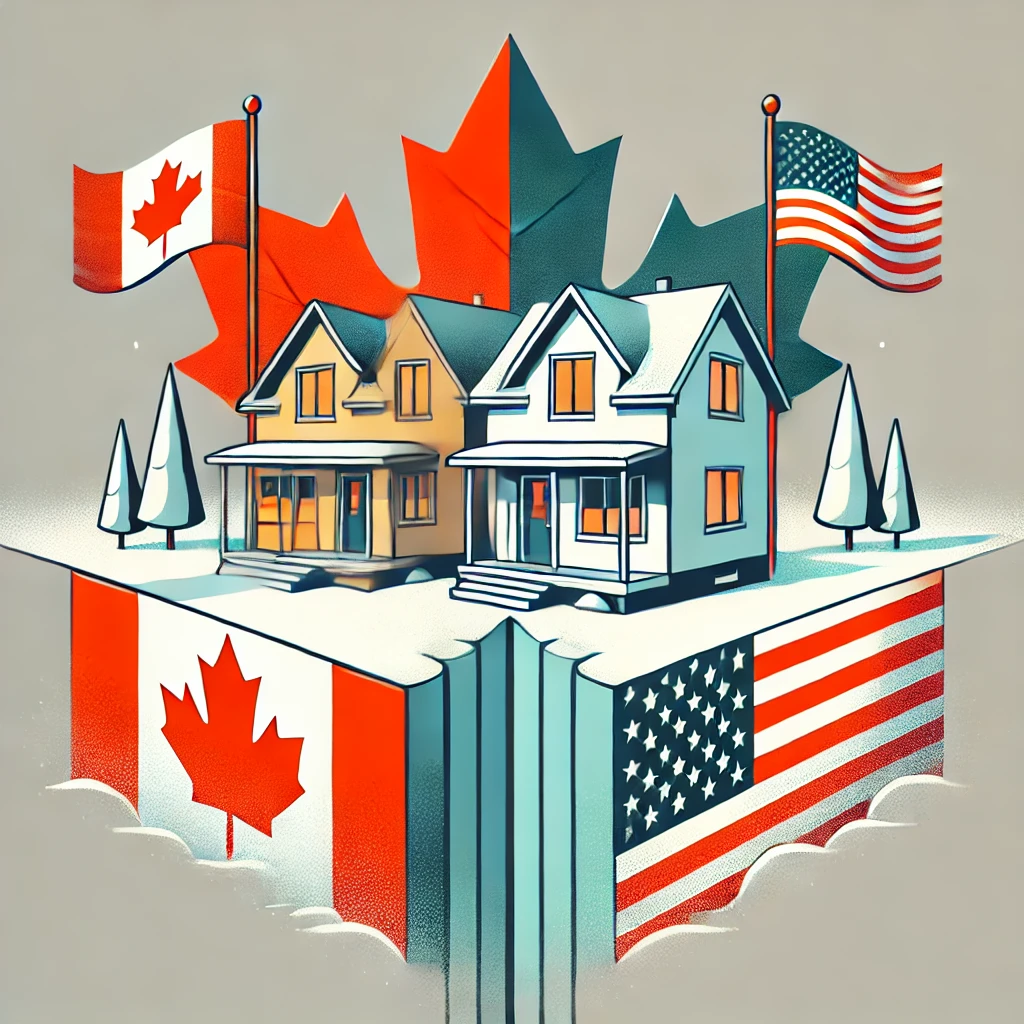When you take out a mortgage, you’re entering into one of the most significant financial agreements of your life. However, many people don’t fully understand the mechanics behind how their mortgage payments are structured and how different countries handle mortgages. In Canada and the United States, mortgage systems are similar on the surface, but there are key differences that can have long-term financial impacts. Let’s dive into how amortized mortgages work and the differences between the Canadian and American systems.
What is an Amortized Mortgage?
An amortized mortgage is a loan in which the borrower makes regular payments over a fixed period, and these payments are divided into two parts: principal and interest. During the initial years of the mortgage, the majority of your payments go toward interest. Over time, as the outstanding loan balance decreases, more of your payment goes toward the principal. The structure of amortized mortgages means that you’re paying more interest upfront, which is why early payments feel like you’re barely chipping away at the loan itself.
This is where the system becomes tricky, especially when interest rates fluctuate, as your payments will mostly be directed toward interest before you start making real progress on the principal.
The Canadian Mortgage System
In Canada, the most common type of mortgage is a 5-year fixed-rate mortgage with a 25-year amortization period. This means that while your mortgage is amortized over 25 years, your interest rate is only locked in for five years. After those five years, you’ll need to renegotiate the rate. With constantly shifting interest rates, this creates an ongoing risk for homeowners. If interest rates go up, your monthly payments could skyrocket, putting you in a precarious financial position.
What’s even more frustrating is that many Canadians believe they have no other option but to keep renewing every 5 years or, at best, 10 years. With rates being renegotiated every few years, banks have more opportunities to increase their earnings through higher interest charges. The result? More of your hard-earned money ends up in the bank’s pocket.
The American Mortgage System
In contrast, the United States offers a 30-year fixed-rate mortgage. This means that homeowners can lock in an interest rate for the entire term of the mortgage, providing more stability and predictability over time. If interest rates rise, homeowners with a fixed rate don’t have to worry about their payments going up. The biggest advantage of the U.S. system is the peace of mind that comes with knowing exactly what you’ll be paying for the life of the loan, making it easier to plan for long-term financial stability.
The Impact of Interest Rate Fluctuations
One of the primary issues with the Canadian system is the constant renegotiation of mortgage rates, which banks use to their advantage. Interest rates can rise significantly over a 25-year period, meaning that Canadians may end up paying much more in interest than they initially expected. Even worse, this constant cycle of refinancing and adjusting rates keeps homeowners in a state of uncertainty.
On the other hand, the American 30-year fixed mortgage locks in a rate for the long term, insulating homeowners from rate fluctuations. As a result, Americans have more control over their long-term housing costs, while Canadian homeowners are often left at the mercy of the market.
Amortization: Paying Interest First
Amortized mortgages, whether in Canada or the U.S., tend to front-load the interest payments. This means that, especially in the first few years, most of your monthly payments go toward paying off the interest rather than reducing the principal. For Canadian homeowners, the issue is further compounded by the shorter fixed-term periods, which makes it difficult to make real progress on the loan before having to renegotiate the interest rate again.
In the U.S., while the mortgage is still amortized, homeowners at least have the reassurance that their interest rate is locked in for the full 30 years. They can focus on paying off their loan without worrying about sudden interest rate hikes.
Breaking the Cycle for Future Generations
The Canadian mortgage system can often feel like a financial trap, constantly renewing with a new interest rate and always paying more upfront in interest. It’s a system that primarily benefits the banks and not the homeowners.
However, there are alternatives. For those looking to break the cycle of dependence on traditional banks, consider exploring financial strategies like the Infinite Banking Concept (IBC). With IBC, you can create your own banking system using Dividend-Paying Participating Whole Life Insurance Policies, giving you control over how you finance major purchases—like a home—without being at the mercy of fluctuating interest rates. This strategy allows you to build and manage your own capital in a way that benefits you, not the banks.
Conclusion
The difference between the Canadian and American mortgage systems is stark, with Canadian homeowners often losing out to a system designed to extract as much profit as possible through frequent renegotiations and front-loaded interest. But knowledge is power. By understanding how these systems work and exploring alternative strategies like IBC, you can regain control of your financial future, protect your family, and stop relying on banks for your biggest financial decisions.
For my family, I’ve decided to take a different approach. I don’t want my children to be at the mercy of the banks and their ever-changing interest rates. Instead, I’m teaching them how to control their financial future so that the only reason they need a bank is for the convenience of using a debit card or withdrawing cash. It’s time to change the narrative and protect our families from financial systems designed to keep us dependent.
4o
When you take out a mortgage, you’re entering into one of the most significant financial agreements of your life. However, many people don’t fully understand the mechanics behind how their mortgage payments are structured and how different countries handle mortgages. In Canada and the United States, mortgage systems are similar on the surface, but there are key differences that can have long-term financial impacts. Let’s dive into how amortized mortgages work and the differences between the Canadian and American systems.
What is an Amortized Mortgage?
An amortized mortgage is a loan in which the borrower makes regular payments over a fixed period, and these payments are divided into two parts: principal and interest. During the initial years of the mortgage, the majority of your payments go toward interest. Over time, as the outstanding loan balance decreases, more of your payment goes toward the principal. The structure of amortized mortgages means that you’re paying more interest upfront, which is why early payments feel like you’re barely chipping away at the loan itself.
This is where the system becomes tricky, especially when interest rates fluctuate, as your payments will mostly be directed toward interest before you start making real progress on the principal.
The Canadian Mortgage System
In Canada, the most common type of mortgage is a 5-year fixed-rate mortgage with a 25-year amortization period. This means that while your mortgage is amortized over 25 years, your interest rate is only locked in for five years. After those five years, you’ll need to renegotiate the rate. With constantly shifting interest rates, this creates an ongoing risk for homeowners. If interest rates go up, your monthly payments could skyrocket, putting you in a precarious financial position.
What’s even more frustrating is that many Canadians believe they have no other option but to keep renewing every 5 years or, at best, 10 years. With rates being renegotiated every few years, banks have more opportunities to increase their earnings through higher interest charges. The result? More of your hard-earned money ends up in the bank’s pocket.
The American Mortgage System
In contrast, the United States offers a 30-year fixed-rate mortgage. This means that homeowners can lock in an interest rate for the entire term of the mortgage, providing more stability and predictability over time. If interest rates rise, homeowners with a fixed rate don’t have to worry about their payments going up. The biggest advantage of the U.S. system is the peace of mind that comes with knowing exactly what you’ll be paying for the life of the loan, making it easier to plan for long-term financial stability.
The Impact of Interest Rate Fluctuations
One of the primary issues with the Canadian system is the constant renegotiation of mortgage rates, which banks use to their advantage. Interest rates can rise significantly over a 25-year period, meaning that Canadians may end up paying much more in interest than they initially expected. Even worse, this constant cycle of refinancing and adjusting rates keeps homeowners in a state of uncertainty.
On the other hand, the American 30-year fixed mortgage locks in a rate for the long term, insulating homeowners from rate fluctuations. As a result, Americans have more control over their long-term housing costs, while Canadian homeowners are often left at the mercy of the market.
Amortization: Paying Interest First
Amortized mortgages, whether in Canada or the U.S., tend to front-load the interest payments. This means that, especially in the first few years, most of your monthly payments go toward paying off the interest rather than reducing the principal. For Canadian homeowners, the issue is further compounded by the shorter fixed-term periods, which makes it difficult to make real progress on the loan before having to renegotiate the interest rate again.
In the U.S., while the mortgage is still amortized, homeowners at least have the reassurance that their interest rate is locked in for the full 30 years. They can focus on paying off their loan without worrying about sudden interest rate hikes.
Breaking the Cycle for Future Generations
The Canadian mortgage system can often feel like a financial trap, constantly renewing with a new interest rate and always paying more upfront in interest. It’s a system that primarily benefits the banks and not the homeowners.
However, there are alternatives. For those looking to break the cycle of dependence on traditional banks, consider exploring financial strategies like the Infinite Banking Concept (IBC). With IBC, you can create your own banking system using Dividend-Paying Participating Whole Life Insurance Policies, giving you control over how you finance major purchases—like a home—without being at the mercy of fluctuating interest rates. This strategy allows you to build and manage your own capital in a way that benefits you, not the banks.
The difference between the Canadian and American mortgage systems is stark, with Canadian homeowners often losing out to a system designed to extract as much profit as possible through frequent renegotiations and front-loaded interest. But knowledge is power. By understanding how these systems work and exploring alternative strategies like IBC, you can regain control of your financial future, protect your family, and stop relying on banks for your biggest financial decisions.
For my family, I’ve decided to take a different approach. I don’t want my children to be at the mercy of the banks and their ever-changing interest rates. Instead, I’m teaching them how to control their financial future so that the only reason they need a bank is for the convenience of using a debit card or withdrawing cash. It’s time to change the narrative and protect our families from financial systems designed to keep us dependent.





Leave a Reply